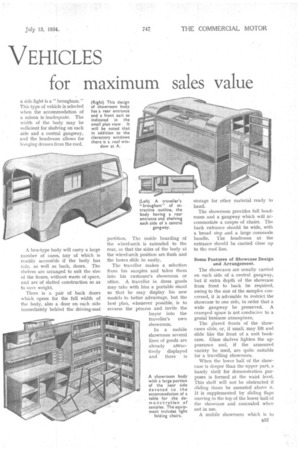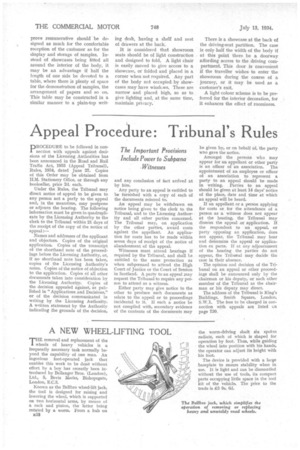DESIGNING TRAVELLERS' VEHICLES
Page 50

Page 51

Page 52

If you've noticed an error in this article please click here to report it so we can fix it.
for maximum sales value
How Doors, Shelves and Showcases May be Arranged in Commercial Travellers' Cars and Mobile Showrooms to Give the Best Effect and
Greatest Convenience
MANY commercial travellers prefer private-car-style bodywork for their vehicles. Although the car may be run for both business and pleasure, this is not necessarily the deciding factor, but rather the maintenance of a tradition. Moreover, during the past 10 years, the standardized saloon has been available in an increasing range of sizes and prices, and, for those who do not wish to incur the expense of a new car, there is no difficulty in finding a good secondhand one.
The saloon is easily adapted to carry samples ; in fact, if soft goods be carried, no alteration of the bodywork is necessary. The folded and often unwrapped samples may be laid on the back cushion, with an assortment of trimmings and so on in small cardboard boxes. .
• Making Good Use of the Available Space.
If more intensive use is to be made of the saloon, then the back cushion and squab are removed, so that shelves may be fitted to accommodate boxes or cases. Assuming that the saloon is the four-door pattern, the shelves extend from the rear pillar of the second doorway to the back of the body and the crossgangway between the second nearside and off-side doors is left clear. The examination of the boxes is facilitated if there be folding tables in the backs of the front seats.
The above arrangement, however, represents only about half of the loading capacity of the saloon. In order to utilize the whole of the space behind the front seats, a back
door may be added. This door gives access to that part of the load which is not readily available if the cross-gangway be filled with samples.
Another method, which is suitable for a large saloon, is to make a third side door, instead of a back one. In this instance, the side of the body
above the wheel-arch is reconstructed to form a door. The second
and wheel-arch doors are fastened without the aid of an intermediate pillar, in a similar manner to that of a "pillarless" saloon, with the
advantage that when the doors are open unobstructed access is provided to the shelving.
The adaptability and general utility of the saloon tend to discourage the use of the two-seater coupe with a large rear boot.
The private-carriage tradition of the commercial traveller is well exemplified by the polite fiction that a vehicle which varies in style from a small private bus to a boxyan with
a side light is a "brougham. This type of vehicle is selected when the accommodation of a saloon is inadequate. The width of the body may be sufficient for shelving on each side and a central gangway, and the headroom allows for hinging dresses from the roof.
A box-type body will carry a large number of cases, any of which is readily accessible if the body has side, as well as back, doors. The shelves are arranged to suit the size of the boxes, without waste of space, and are of slatted construction so as to save weight.
There is a pair of back doors which opens for the full width of the body, also a door on each side immediately behind the driving-seat partition. The inside boarding of the wheel-arch is extended to the rear, so that the sides of the body at the wheel-arch position are flush and the boxes slide in easily.
The traveller makes a selection from his samples and takes them into his customer's showroom. or office. A traveller in dress goods may take with him a portable stand so that he may display his new models to better advantage, but the best plan, whenever possible, is to reverse the process and invite the buyer into the traveller's own showroom.
In a mobile showroom several lines of goods are already attractively displayed and there is
storage for other material ready to hand.
The showroom provides full headroom and a gangway which will accommodate a couple of chairs. The back entrance should be wide, with a broad step and a large commode handle. The headroom at the entrance should be carried close up to the roof line.
Some Features of Showcase Design and Arrangement.
The showcases are usually carried on each side of a central gangway, but if extra depth of the showcase from front to back be required, owing to the size of the samples concerned, it is advisable to restrict the showcase to one side, in, order that a wide gangway be preserved. A cramped space is not conducive to a genial business atmosphere.
The glazed fronts of the showcases slide, or, if small, may lift and slide like the front of a unit bookcase. Glass shelves lighten the appearance and, if the armoured variety be used, are quite suitable for a travelling showroom.
When the lower half of the showcase is deeper than the upper part, a handy shelf for demonstration purposes is formed at the waist level. This shelf will not be obstructed if sliding doors be mounted above it. It is supplemented by sliding flaps moving in the top of the lower half of the showcase and concealed when not in use.
A mobile showroom which is to
prove remunerative should be designed as much for the comfortable reception of the customer as for the display and storage of samples. Instead of showcases being fitted all around the interior of the body, it may be an advantage if half the length of one side be devoted to a table, where there is plenty of space for the demonstration of samples, the arrangement of papers and so on. This table may be constructed in a similar manner to a plain-top writ ing desk, having a shelf and nest of drawers at the back.
It is considered that showroom seats should be of light construction and designed to fold. A light chair is easily moved to give access to a showcase, or folded and placed in a corner when not required. Any part of the body not occupied by showcases may have windc,ws. These are narrow and placed high, so as to give lighting and, at the same time, maintain privacy.. There is a showcase at the back of the driving-seat partition. The case is only half the width of the body if at this point there be a doorway affording access to the driving compartment This door is convenient if the traveller wishes to enter the showroom during the course of a journey, or it may be used as a customer's exit, A light colour scheme is to be preferred for the interior decoration, for it enhances the effect of roominess.




























































































